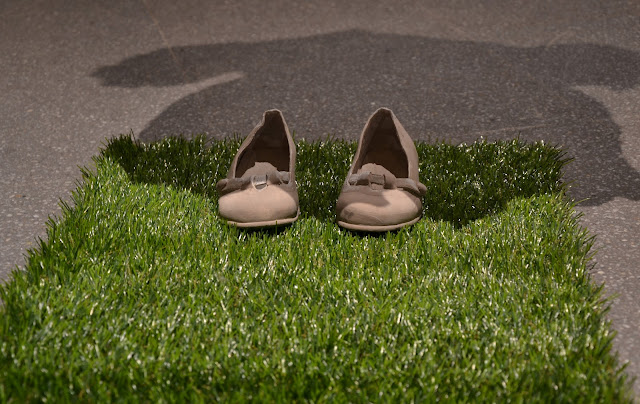Vestidos, zapatos, césped natural y cenizas
Medidas variables
"Escenografía de una vida[1]," 2011
Clothing, shoes, natural turf and ashes
Variable dimensions
La española Planells trabaja con el medio de la instalación. Tras una reflexión sobre la intensidad de la memoria como testimonio del pasado, realiza en el presente una reflexión sobre el elemento constituyente de nuestro ser actual.
Clothing, shoes, natural turf and ashes
Variable dimensions
En la exposición fluyen lugares y fragmentos de la objetividad que (antes que estética) son fuente de una fuerte mediación perceptiva. En el universo de la iconografía contemporánea, uno de los puntos de pasaje imprescindible es nuevamente el análisis de la cotidianidad reducida según posiciones peculiares de carácter sugestivo… Aunque se parte de una diferencia técnica y formal, hay una línea de continuidad en la obra de la autora.
La artista española centra directamente la atención sobre la reconstrucción del “inscape” como reflejo de una mirada existencial. En esta práctica de realidad filtrada desde sensores individuales, ¿cómo encontrar el punto de unión con la perspectiva identitaria y de realidad? Es necesario releer los trabajos sabiendo que esas expresiones son filiaciones de algunos caracteres difusos que la influencian. En este caso, la memoria personal está inevitablemente contaminada con estructuras culturales. Lo mismo sucede con la visión del mismo lugar, por ejemplo: la acción de los mecanismos de mediación cultural registra la percepción de la realidad y no la realidad en sí mismo.
Carlo Sala. Curador Fondazione Francesco Fabbri
The Spanish woman Planells works with the medium of the installation. Realised in the present, it turns into a reflection on intense memory as testimony of the past and the constitutive element of our current being.
In the exhibition flow places and fragments of objectivity that are the source of a strong perceptive mediation, before aesthetics. In the universe of contemporary iconography, one of the essential points of passage is again the analysis of the reduced quotidian according to peculiar positions of a suggestive character . . . Even starting from a technical and formal difference, there is a line of continuity in the author's work.
The Spanish artist directly turns the attention to the reconstruction of the “inscape”[1] as reflection of an existential gaze. In this practice of reality filtered from individual sensors, how can one encounter the point of union with the identitarian perspective and reality? It is necessary to reread the works knowing that those expressions are filiations of some diffuse characters that influence her.[2] In this case, personal memory is inevitably contaminated with cultural structures. Also in the view of the same place; in particular the action of the mechanisms of cultural mediation, which do not register a reality in itself, but its perception.
Carlo Sala. Curator "Fondazione Francesco Fabbri"[3]
Carlo Sala. Curador Fondazione Francesco Fabbri
The Spanish woman Planells works with the medium of the installation. Realised in the present, it turns into a reflection on intense memory as testimony of the past and the constitutive element of our current being.
In the exhibition flow places and fragments of objectivity that are the source of a strong perceptive mediation, before aesthetics. In the universe of contemporary iconography, one of the essential points of passage is again the analysis of the reduced quotidian according to peculiar positions of a suggestive character . . . Even starting from a technical and formal difference, there is a line of continuity in the author's work.
The Spanish artist directly turns the attention to the reconstruction of the “inscape”[1] as reflection of an existential gaze. In this practice of reality filtered from individual sensors, how can one encounter the point of union with the identitarian perspective and reality? It is necessary to reread the works knowing that those expressions are filiations of some diffuse characters that influence her.[2] In this case, personal memory is inevitably contaminated with cultural structures. Also in the view of the same place; in particular the action of the mechanisms of cultural mediation, which do not register a reality in itself, but its perception.
Carlo Sala. Curator "Fondazione Francesco Fabbri"[3]
[1] Translator's note: This is in English in the ST as well.
[2] It is not clear
here what the ST "le" refers to. I choose the TT "her," as
Planells is the originator of the work and the ideas that accompany it. I
consider this in line with the general philosophy in the paragraph. However I
am adding in a more specific lexical category than the ST contains: I do so at
risk of failing in this part of the translation task.
[3] Translator's note: This appears to be in Italian.










